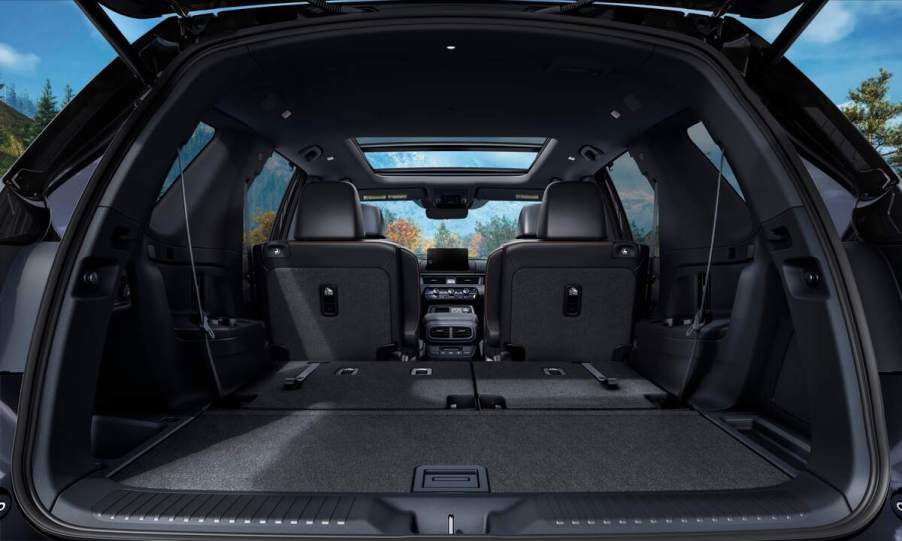
6 Midsize SUVs Fail to Impress in New IIHS Rear Seat Safety Testing
Manufacturers have made incredible advancements in car safety tech over the past 30 years. These advances are primarily thanks to more stringent testing. In 1995, the Insurance Institute for Highway Safety (IIHS) introduced the moderate overlap frontal test. It simulates two cars driving at 40 mph and getting into a near head-on collision. The IIHS designed the test to help protect riders if a vehicle crosses the center line and impacts a car in the oncoming lane. To determine the effect such a collision would have on the occupants, testers place a dummy in the driver’s seat and crash the car into a barrier.
But recently, the IIHS changed the test to ensure the backseat passengers are as safe as those in the front. And unfortunately, six midsize SUVs scored poorly in the new rear-seat safety testing.
How has the IIHS changed its rear seat safety testing?
The old IIHS test used data from a crash dummy in the driver’s seat, but the new test adds a second dummy to the back row, calibrated to test for injuries most likely to affect rear-seat occupants. The test uses sensors to detect movement, ensuring the restraints correctly hold the dummy in place to avoid damage. The updated test also uses pressure sensors to gauge the risk of chest and abdominal injuries.
The main reason for the shift in focus is advancements in the structural integrity of the passenger compartment. In the past, rear-seat occupants were considered safer primarily due to the crumpling of the front occupant compartment, the IIHS reports. But thanks to the advancements over the past 30 years, the passenger compartment experiences little to no deformation in the moderate overlap test. As a result, belted rear-seat passengers are now at a 46% greater risk of injury than belted front-seat passengers.
This increased fatality rate isn’t entirely due to the rigidity of the passenger compartment but also because many automakers have not added technologies like pretensioners and load limiters to the rear seats. Ultimately, the rear seats have not become unsafe; instead, they haven’t kept up with the safety enhancements for the front seats.
6 midsize SUVs received poor ratings in the new IIHS rear seat safety testing
Rear-seat safety is not essential to all consumers, but it’s critical to families. Most folks shopping for SUVs intend to haul family members around, so protecting rear-seat passengers is paramount. Unfortunately, the Honda Pilot, Hyundai Palisade, Jeep Grand Cherokee, Jeep Wrangler four-door, Mazda CX-9, and Nissan Murano received poor ratings on the updated IIHS test.
According to the NHTSA, 51% of passenger cars’ rear seats don’t have pretensioners and load limiters. As a result, the Grand Cherokee, CX-9, Palisade, and Pilot all had high belt tension, according to the IIHS.
Regarding the Grand Cherokee, the testing concluded the belt tension could cause potential chest injury. The Wrangler is the worst offender because it’s not equipped with load limiters, pretensioners, or curtain airbags. The other five SUVs put passengers at high risk for head and neck injuries, and that risk is significant in the Wrangler, the IIHS reports.
Honda, Mazda, and Hyundai are making improvements to upcoming models

These IIHS test results might seem like bad news, but many vehicles can reclaim their good rating with upcoming models.
Jennifer Morrison, Mazda’s vehicle safety compliance, planning, and development manager, told Consumer Reports that the 2024 Mazda CX-90, the CX-9’s replacement, will have pretensioners and load limiters. And Honda spokesperson Chris Martin expressed that the 2023 Pilot, which marks the start of the nameplate’s fourth generation, includes those same updates. Although Hyundai hasn’t commented on any specific updates for the Palisade, company spokesperson Michael Stewart told Consumer Reports there was an “aggressive plan to implement countermeasures to improve restraint technologies for rear occupant protection.”
Those automakers already intend to improve safety for passengers in the back seats, but others are already doing that well.
The Ford Explorer, Ford Mustang Mach-E, Subaru Ascent, and Tesla Model Y received good ratings in the updated IIHS testing. According to a chart provided by the IIHS, the Mach-E is the only vehicle to earn a good rating in every category. The Chevy Traverse, Toyota Highlander, and Volkswagen Atlas received marginal ratings. However, it’s worth noting the Atlas and Highlander put rear passengers at slightly less risk than the Traverse.
Also worth noting is the “new results don’t change much for those who use forward- or rear-facing five-point child restraints to transport kids,” CR says. IIHS spokesperson Joe Young told Consumer Reports that parents “should rest assured those seats provide a high level of crash protection” regardless of their updated IIHS rear-seat passenger safety ratings.
Most small SUVs didn’t score well, either
Late last year, the IIHS performed its first round of updated testing on a batch of late-model compact SUVs, and the results were similar. Almost all received a poor rating, including popular models like the Honda HR-V and CR-V, Hyundai Tuscon, and Mazda CX-5. The Subaru Forester, Nissan Rogue, and Audi Q3 received a marginal score.
But a few small SUVs passed with flying colors. Ford Escape models built after May 2022 and the Volvo XC40 earned a good rating. Like the Mach-E, the Volvo XC40 was the only vehicle in its class to get a perfect score. And the Toyota RAV4 earned an acceptable rating.



